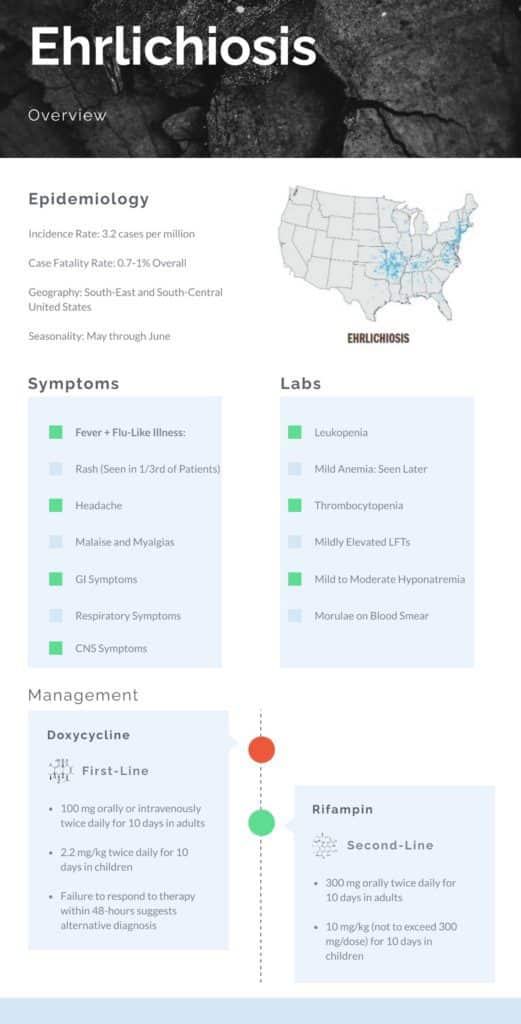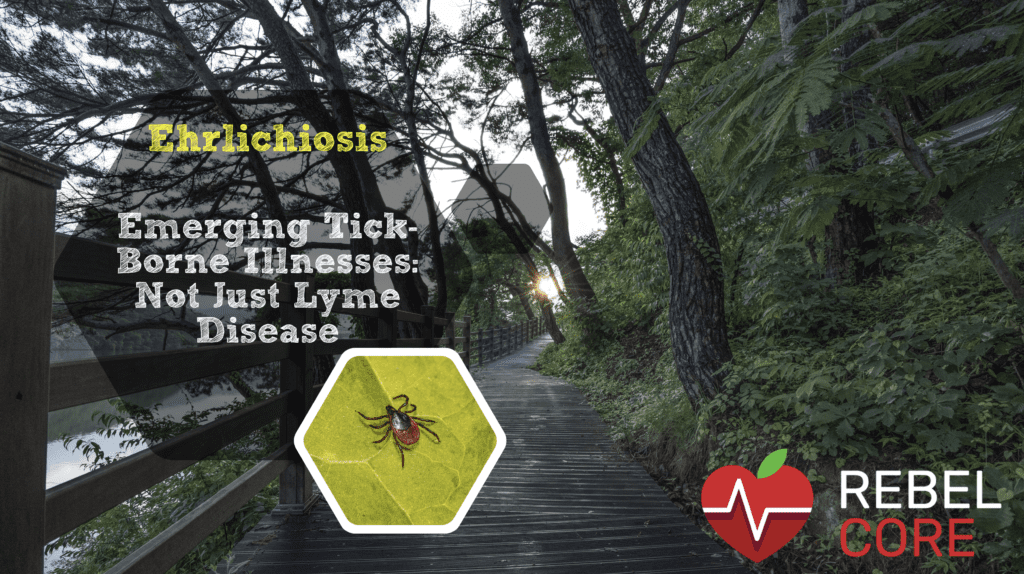
Ehrlichiosis
Epidemiology
Incidence:
- Overall annual incidence noted to be 3.2 cases per million in the United States between 2008 and 2012 (Biggs 2016)
- Highest incidence occurs in those 60-69 years of age (Biggs 2016)
Age:
- Median age is 55 years of age with 64% of cases reported in Caucasian patients (Heitman 2016)
Gender:
- Slight male to female predominance (Heitman 2016)
Morbidity/Mortality:
- Case fatality rate is estimated to be 0.7-1% overall (Heitman 2016).
- Case fatality rate is highest in those over under 5 years of age and over 70 years of age
Geography and Seasonality (Heitman 2016): Cases most frequently reported in the Southeastern and Southcentral United States
- Six States account for over 54% of all reported cases
- Oklahoma
- Missouri
- Delaware
- Arkansas
- Missouri
- Tennessee
- Seasonal distribution is concentrated from May through July
Poor Prognostic Factors (Biggs 2016):
- Increased Age
- Immunocompromised States
- Delays in diagnosis and treatment
- Use of sulfonamide antimicrobial
Pathogenesis (Biggs 2016):
- After tick transmissibility, chaffennis, an obligate intracellular bacterial, has a predilection for monocytes and tissue macrophages, specifically neutrophils
- Once infected, the organism multiplies within cytoplasmic membrane-bound vacuoles forming clusters of bacterial called morulae
- Infection elicits a systemic inflammatory response with multiorgan involvement, particularly the spleen, lymphatic system, and bone marrow
History and Physical:
Symptoms (Biggs 2016):
- Symptoms typically appear 5-14 days after bite of an infected tick
- Rash is present more often than Anaplasmosis
- Present in up to 1/3rd of patients
- Typically occurs 5 days after illness onset
- Fever occurs in 96% of recognized cases of ehrlichiosis along with other non-specific flu-like symptoms:
- Headache
- Malaise
- Myalgias
- Gastrointestinal symptoms are often seen unlike Anaplasmosis
- Very commonly seen in children
- Respiratory symptoms or Cough is present in approximately 28% of patients
- Central Nervous System involvement is present in approximately 20% of patients
- Meningitis and Meningoencephalitis
- Severe Manifestations: Most cases are self-limiting, but Ehrlichiosis has been associated with the following severe disease manifestations:
- Shock
- Renal Failure
- Hepatic Failure
- Coagulopathy
- Hemorrhagic Manifestations
- Hemophagocytic Syndromes
- ARDS
Diagnosis:
Labs: Characteristic laboratory findings are seen in Ehrlichiosis along fever and non-specific flu-like illness:
- Leukopenia
- Thrombocytopenia
- Mild Anemia: Occurs later in illness than thrombocytopenia or leukopenia
- Mild to Moderate Elevated Hepatic Transaminase
- Mild to Moderate Hyponatremia
Blood Smear:
- May see morulae with microscopic examination of blood smears but blood smear may be relatively insensitive and inconsistent and is dependent on operator experience (Biggs 2016)
- Observation of morulae is seen much less commonly than in Anaplasmosis
Confirmatory Testing:
- Serological testing of IgM and IgG antibodies using indirect immunofluorescence assay (IFA) is available for diagnosis
- RT-PCR assays is available for diagnosis and is most sensitive during the first week of illness and is the test of choice
- Immunohistochemical staining of skin, tissue, or bone marrow biopsies has also been used for diagnosis

Guest Post By:

Akash Ray, DO
PGY-2 Emergency Medicine Resident Inspira Medical Center
Vineland, NJ
Twitter: @_kashray
References:
- Biggs H et al. Diagnosis and Management of Tickborne Rickettsial Diseases: Rocky Mountain Spotted Fever and Other Spotted Fever Group Rickettsioses, Ehrlichioses, and Anaplasmosis – United States. MMWR Recomm Rep. 2016. PMID: 27172113
- Heitman N at al. Increasing Incidence of Ehrlichiosis in the United States: A Summary of National Surveillance of Ehrlichia chaffeensis and Ehrlichia ewingii Infections in the United States, 2008-2012. Am J Trop Med Hyg. 2016. PMID: 26621561
Post Peer Reviewed By: Salim R. Rezaie, MD (Twitter: @srrezaie)
The post Emerging Tick-Borne Illnesses: Not Just Lyme Disease Part 3 Ehrlichiosis appeared first on REBEL EM - Emergency Medicine Blog.

